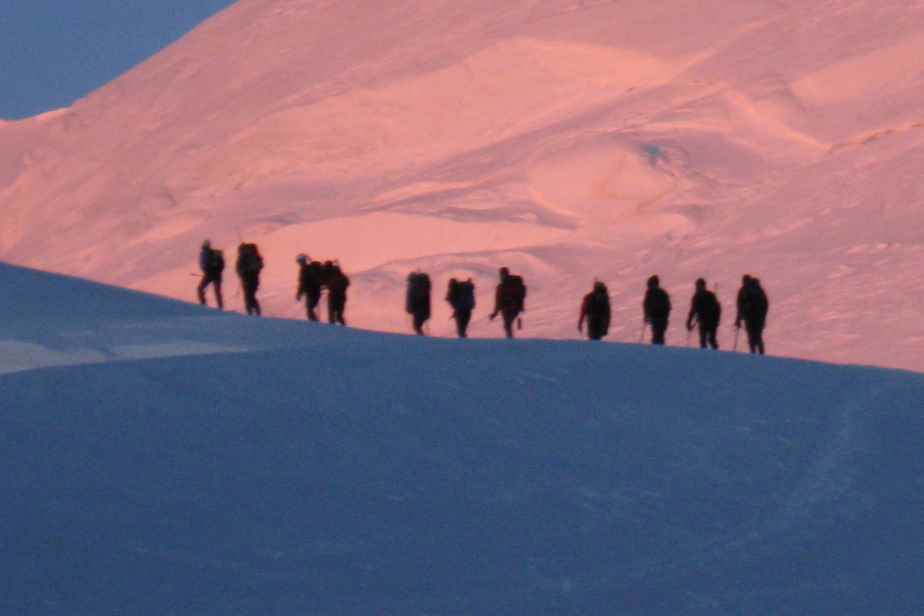Many mountaineers had to change their plans this summer in the Alps: the heat wave made several popular objectives, such as Mont Blanc and the Matterhorn, far too perilous to attempt. This is an example of the negative effects of climate change on the world of mountaineering.
Posted at 11:30 a.m.
“It’s sad to see that, but at the same time, there will be a new balance that will make it possible to climb these routes again,” says Christophe Kinnard, professor in the department of environmental sciences at the University of Quebec at Trois-Rivières (UQTR), specialist in glaciology and amateur mountaineer.
From the middle of summer, associations of professional guides stopped offering the ascent of Mont Blanc, the highest peak in Western Europe, by the normal route, which passes through the refuges of the Tête rousse and of the snack. They also stopped guiding the Matterhorn, on the border of Switzerland and Italy. It had become too dangerous to walk these routes due to increasingly massive and frequent rockfalls.
Defrosting
Christophe Kinnard explains the phenomenon. “The rock is frozen in place by mountain permafrost. When there are major heat waves like those of this summer, we eat deeper into the permafrost and this dislodges loose material. Rocks that were frozen in place will break loose. We have a lot more wall breaks, collapses and avalanches. »

PHOTO PROVIDED BY CHRISTIOPHE KINNARD
Professor and specialist in glacialogy Christophe Kinnard, in the field
From mid-July, the prefect of Haute-Savoie and the mayor of Saint-Gervais recommended no longer climbing Mont Blanc by the normal route due to falling rocks. Mayor Jean-Marc Peillex, who does not have his tongue in his pocket, found that there were still “creepy candidates for death” who wanted to reach the summit of Mont Blanc. Tired of the fight, he ordered the closure of the Tête rousse and Goûter refuges to counter the “crazy and reckless who prank us”.
The end of the heat wave and some precipitation led the mayor to allow the reopening of the two refuges on August 20th. He did, however, offer some caveats.
-

PHOTO PHILIPPE DESMAZES, AGENCE FRANCE-PRESSE
The normal Mont Blanc route crosses the Couloir du Goûter, which is very dangerous due to frequent rock falls.
-

PHOTO DENIS BALIBOUSE, REUTERS
Climbing Mont Blanc is a popular goal for mountaineers.
-

PHOTO GETTY IMAGES
The Matterhorn, on the border of Switzerland and Italy, is an important tourist attraction.
1/3
The royal access route to the summit of Mont Blanc via Saint-Gervais, known as du Goûter, is and will remain a mountaineering route, it will never be the star attraction of a large leisure park where the falling rocks would be in polystyrene. Nor can this route be a training ground for trail runners in shorts and sneakers, lacking in red blood cells.
Jean-Marc Peillex, Mayor of Saint-Gervais
Ice cream parlors too
It’s not just falling rocks that are worrying. On July 3, in Italy, a section of the Marmolada glacier collapsed, causing the death of 11 hikers.

PHOTO MARCO BERTORELLO, FRANCE-PRESSE AGENCY
The melting of the Planpincieux glacier in Courmayeur, Italy, is causing concern.
“In recent years, we have witnessed an upsurge in glacier collapses,” says Christophe Kinnard. It’s not something that was very common before. He explains that the so-called temperate glaciers melt almost continuously in summer (to regain volume in winter).
“It is normal for water to seep into the base. It allows the glacier to move forward, but there are always anchor points. But if there is too much water, the glacier loses these anchor points and will begin to float on a layer of water, which can cause catastrophic shifts with the following effects: debris avalanches , ice, water. »

PHOTO YANNICK FLEURY, LA PRESSE ARCHIVES
The Athabasca Glacier near Jasper in the Rocky Mountains is also experiencing significant melting.
The UQTR professor returns from the Rocky Mountains, where he gave a geography lesson on the mountain environment. Over the years, he has noticed significant retreat of glaciers. However, there are some encouraging things on the horizon.
“For a majority of people, the awareness is made, he believes. If we are not in action, we are at least in the will to act. »
Christophe Kinnard believes in particular that young people are more aware than previous generations and that they adopt more small gestures likely to help the environment.
As for the mythical alpine routes, they will stabilize when everything that is not consolidated will eventually fall. In the meantime, local guides are experts in finding safer but equally exciting routes.
Suggested video
Small river, big fun
Kayakers tackle a very pretty little river in Norway.
digit of the week
40
This is the number of young that a garter snake can have at the end of summer.

